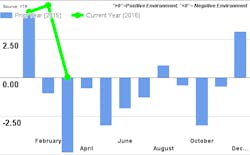It may be too soon to say the party is over for shippers, but metaphorically speaking, all the food and drinks have run out and the party’s host has started dimming the lights. FTR’s Shippers Conditions Index (SCI), a measurement of various factors affecting the shippers’ transportation environment, fell back into negative territory in May to a reading of -2.8, following five months of positive (favorable to shippers) readings.
According to FTR’s analysis, market signals remain very mixed with some seasonal increase in spot freight rates negatively affecting the SCI. FTR believes that the index will probably remain close to neutral until Congress decides if and when to reinstate the 34-hour Hours of Service restart rule for truck drivers. Such a reinstatement would constrict capacity, which would result in more negative readings for the SCI.
“Shippers have taken full advantage of the current capacity lull as indications are that the bid season has been difficult for carriers,” says Larry Gross, partner at FTR. “Now rising spot rates may be signaling the start of a slow reversal in circumstances back toward the carriers, but much will depend on whether the regulatory agenda continues to unfold on schedule.”
The Shippers Conditions Index is a compilation of factors affecting the shippers transport environment. Any reading below zero indicates a less-than-ideal environment for shippers.
Meanwhile, according to the Cass Freight Index, freight shipments and expenditures were up slightly in June after three months of lackluster performance. The June freight shipments index climbed 1.7% over the previous month, although shipments were 4.3% below last year and 7.6% lower than June 2014.
According to Rosalyn Wilson, president of consulting firm FreightMatters, “The first half of the year’s economic performance has been perplexing. Consumer spending has been growing, although the effect on freight is small as most of this increase has been in the service sector (which hired 256,000 new workers in June). Inventories are mostly unchanged at uncomfortably high levels, but the inventory-to-sales ratio fell in April for the first time in over a year.”
Both exports and imports are down, Wilson notes, and consumer spending has been weak. On the positive side, the manufacturing sector has seen a 3.9% growth in production. Overall, Wilson observes, “While the second quarter was stronger than the first, the mixed signals in the air make the third quarter uncertain.”




